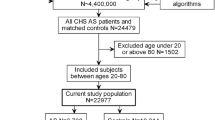Abstract
It has been reported that renal stone formation increased in patients with ankylosing spondylitis (AS). However, its reason remains unclear. The aim of this study was to evaluate serially the possible risk factors for renal stone formation in AS patients. Two groups consisted of AS patients with renal stone (n = 30), AS patients without renal stone (n = 30), and 20 healthy controls (HC) were included to the study. Parathyroid hormone, calcium, magnesium, phosphorus and immunoglobulin A levels and 24 h urine were evaluated at baseline, and three times monthly. Serum calcium levels were higher in AS patients with urolithiasis than those without at baseline and third-month evaluation (baseline: 9.53 ± 0.3 vs 9.32 ± 0.3 mg/dl; p < 0.03; at third-month evaluation: 9.74 ± 0.2 vs 9.56 ± 0.3 mg/dl; p < 0.01). No significant differences were found between groups in terms of PTH and magnesium levels. In all evaluation times, although urinary calcium excretion was higher in AS patients with urolithiasis than in those without, it did not reach a statistical significance. IgA levels were significantly higher in renal stone sufferers than HC patients in all evaluation times.AS patients with urolithiasis also had high IgA levels compared with AS patients without renal stone at the second-month evaluation time (276 ± 102 vs 219 ± 104 mg/dl, p < 0.002). Increased levels of serum calcium and IgA levels as well as family history for urolithiasis may be an indicator of the development of urolithiasis in AS patients.
Similar content being viewed by others
References
Korkmaz C, Ozcan A, Akçar N (2005) Increased frequency of ultrasonographic findings suggestive of renal stones in patients with ankylosing spondylitis. Clin Exp Rheumatol 23:389–392
Jakobsen AK, Jacobsson LT, Patschan O, Askling J, Kristensen LE (2014) Is nephrolithiasis an unrecognized extra-articular manifestation in ankylosing spondylitis? A prospective population-based Swedish national cohort study with matched general population comparator subjects. PLoS One 25:9
Van der Linden S, Valkenburg HA, Cats A (1984) Evaluation of diagnostic criteria for ankylosing spondylitis. A proposal for modification of the New York criteria. Arthritis Rheum 27:361–368
Garrett S, Jenkinson T, Kennedy LG, Whitelock H, Gaisford P, Calin A (1994) A new approach to defining disease status in ankylosing spondylitis: the Bath Ankylosing Spondylitis Disease Activity Index. J Rheumatol 21:2286–2291
Calin A, Garrett S, Whitelock H, Kennedy LG, O’Hea J, Mallorie P, Jenkinson T (1994) A new approach to defining functional ability in ankylosing spondylitis: the development of the Bath Ankylosing Spondylitis Functional Index. J Rheumatol 21:2281–2285
Lui NL, Carty A, Haroon N, Shen H, Cook RJ, Inman RD (2011) Clinical correlates of urolithiasis in ankylosing spondylitis. J Rheumatol 38:1953–1956
Cansu DU, Calışır C, Savaş Yavaş U, Kaşifoğlu T, Korkmaz C (2011) Predictors of radiographic severity and functional disability in Turkish patients with ankylosing spondylitis. Clin Rheumatol 30:557–562
Resorlu M, Gokmen F, Resorlu H, Adam G, Aylanc N, Akbal A, Ozdemir H (2015) Prospective evaluation of the renal morphology and vascular resistance inpatients with ankylosing spondylitis. Med Ultrason 17:180–184
Gratacós J, Collado A, Filella X, Sanmartí R, Cañete J, Llena J, Molina R, Ballesta A, Muñoz-Gómez J (1994) Serum cytokines (IL-6, TNF-alpha, IL-1 beta and IFN-gamma) in ankylosingspondylitis: a close correlation between serum IL-6 and disease activity andseverity. Br J Rheumatol 33:927–931
Gratacós J, Collado A, Pons F, Osaba M, Sanmartí R, Roqué M, Larrosa M, Múñoz-Gómez J (1999) Significant loss of bone mass in patients with early, active ankylosing spondylitis: a followup study. Arthritis Rheum 42:2319–2324
Pacifici R (1997) Idiopathic hypercalciuria and osteoporosis-distinct clinical manifestations of increased cytokine induces bone resorption? J Clin Endocrinol Metab 82:29–31
Will R, Bhalla AK, Palmer R, Ring R, Calin A (1989) Osteoporosis in early ankylosing spondylitis: a primary pathological event? Lancet II:1483–1485
Maghraoui AE (2004) Osteoporosis and ankylosing spondylitis. Jt Bone Spine 71:291–295
Fallahi S, Jamshidi AR, Gharibdoost F, Mahmoudi M, Paragomi P, Nicknam MH, Farhadi E, Qorbani M (2012) Urolithiasis in ankylosing spondylitis: correlation with BASDAI, BASFI and BASMI. Casp J Intern Med 3:508–513
Veys EM, van Laera M (1973) Serum IgG, IgM, and IgA levels in ankylosing spondylitis. Ann Rheum Dis 32:493–496
Shodjai-Moradi E, Ebringer A, Abuljadayel I (1992) IgA antibody response to Klebsiella in ankylosing spondylitis measured by immunoblotting. Ann Rheum Dis 51:233–237
Cowling P, Ebringer R, Ebringer A (1980) Association of inflammation with raised serum IgA in ankylosing spondylitis. Ann Rheum Dis 39:545–549
Ardiçoğlu O, Atay MB, Ataoğlu H et al (1996) IgA antibodies to Klebsiella in ankylosing spondylitis. Clin Rheumatol 15:573–576
Author information
Authors and Affiliations
Corresponding author
Ethics declarations
Conflict of interest
The authors have no conflict of interest to declare.
All procedures performed in the study are in accordance with the ethical standards of the institutional research committee and with the 1964 Helsinki declaration and its later amendments or comparable ethical standards.
Informed consent forms were obtained from all individual participants included in the study.
Additional information
Key message
Blood and urine calcium levels tended to be high in AS patients with urolithiasis. Family history for urolithiasis and high Ig A levels may provide important clue on the development of urolithiasis in AS patients.
Electronic supplementary material
Below is the link to the electronic supplementary material.
Rights and permissions
About this article
Cite this article
Gönüllü, E., Bilge, N.Ş.Y., Cansu, D.U. et al. Risk factors for urolithiasis in patients with ankylosing spondylitis: a prospective case–control study. Urolithiasis 45, 353–357 (2017). https://doi.org/10.1007/s00240-016-0911-8
Received:
Accepted:
Published:
Issue Date:
DOI: https://doi.org/10.1007/s00240-016-0911-8




